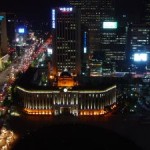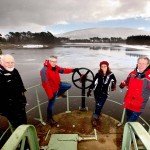For a total investment of £315,000, the Harlaw Hydro Reservoir scheme at Balerno, East of Edinburgh, is expected to generate more than £50,000 per year. Once the scheme has paid for itself (in less than 7 years), that annual revenue will be available for village improvement schemes for a further 13 years.  The scheme will continue to generate income for at least 50 years.
The scheme will continue to generate income for at least 50 years.
A meeting at Balerno village hall in mid-April 2013 to launch a share prospectus for the scheme was standing room only. Shareholders will earn a 6% annual fixed return on their investment. Within two weeks, £95,000 of shares were sold.
The Harlaw dam and its reservoir were originally constructed 150 years ago to ensure that the woollen mills on the River Leith had a constant water supply during the summer months. Water can be released from the dam through two outlet pipes that run under the dam from the base of two outlet towers that stand in the reservoir. The dam and its environs were bought by Edinburgh City Council some years ago, as part of their Flood Prevention Scheme for the River Leith.
The 65kW hydro turbine will feed off the outlet pipe (known as an outlet penstock) from one of the towers. It is expected to generate more than 265,000 kWh of electricity each year that will earn 20.21 pence per kWh under the feed-in tariff scheme for its first 20 years of operation.
Harlaw Hydro Limited, an entity established by Balerno Village Trust to develop and operate the hydro scheme, have decided on a crossflow turbine because of its suitablility to the geography, its relatively low cost (around £120,000), its continued efficiency when levels in the reservoir fluctuate, and its low maintenance costs. The committee benefited from 160 years of detailed records of rainfall, level and flow rates at the dam.
The Balerno Village Trust had been promoting more sustainable living for a number of years before they took on the hydro project in 2009. They jointly commissioned a study that looked at a range of sites along the River Leith before settling on the project at Harlaw dam.
Profitable without subsidy
Their goal was to deliver a return on investment of between 8% and 10% purely through electricity sales without any subsidy – the Harlaw project promised that sort of return. Adding feed-in tariff revenues converted it to a project with a rate of return between 20% and 30%.
A small hydro turbine had been installed to power lighting in the dam-keeper’s cottage around 100 years ago. It had eventually fallen into disrepair. But it meant that much of the infrastructure for a more efficient modern turbine was already in place. The demolition of the old turbine house and its replacement with a modern brick and block building, the installation of the turbine plus 30 meters of pipe, and a power connection to a sub-station around 50 meters away, are the major requirements of the project.
Approval of their application for a connection to the nearest sub-station is expected in May. Construction of the turbine house is due to start in March 2014. However, the weather will need to be better than it has been in March 2012 and 2013 if it is to go ahead. Fabrication and delivery of the turbine will take around six months from final confirmation of the order.
Should this project prove as trouble-free and as lucrative as promised, the possibility of a second and larger turbine for the outlet leading from the Harlaw reservoir tower in deeper water will be investigated.







[…] Harlaw Hydro Project at Balerno, East of Edinburgh, may be small, but it has faced some major challenges. It has been […]